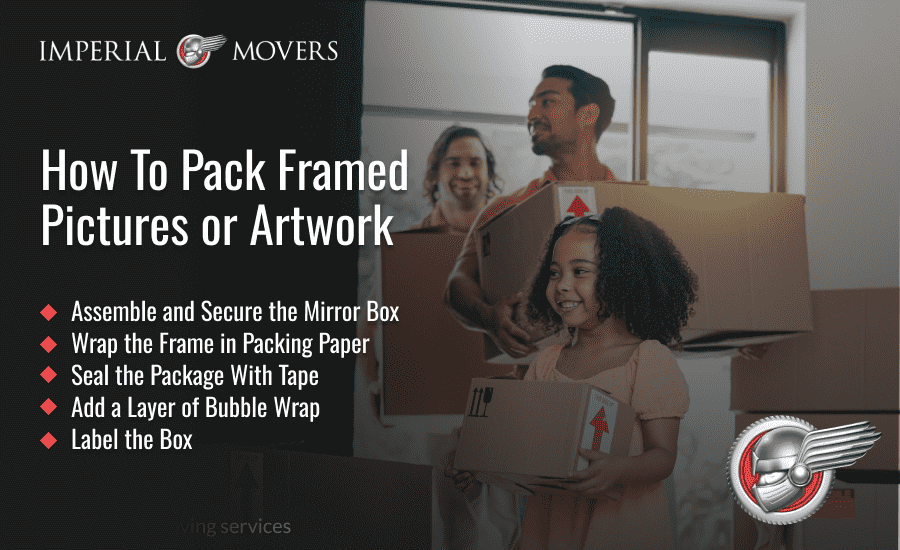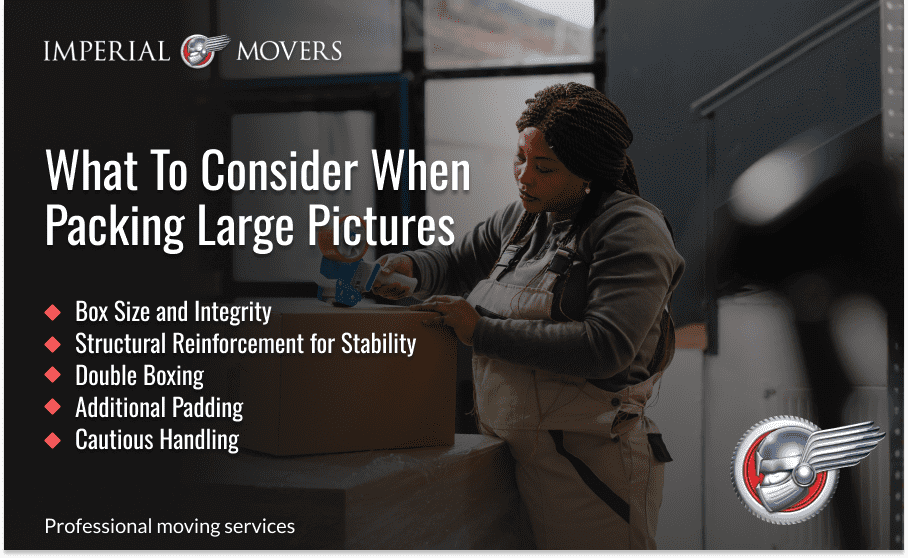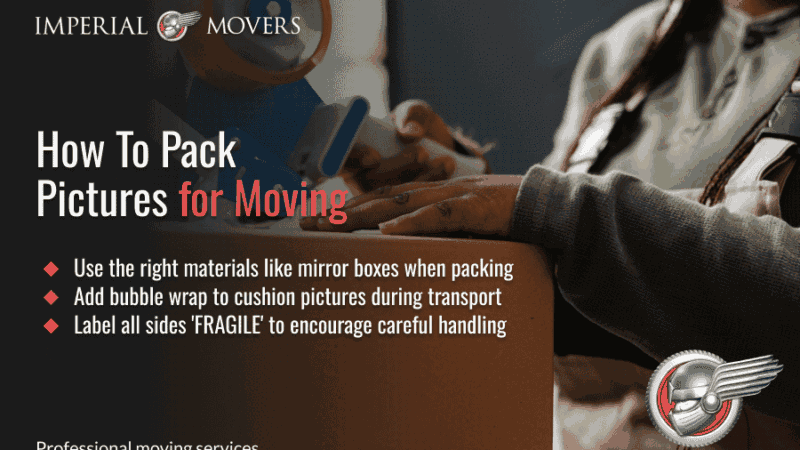How To Pack Pictures for Moving: Key Points
- Use sturdy boxes, corner protectors, packing paper, and bubble wrap to protect frames and glass
- When packing pictures, lay the frame face down on packing paper, then wrap it like a gift, making sure the entire surface is fully covered
- Clearly label all sides of the box with “FRAGILE” in bold letters, and mark the top with “THIS SIDE UP” to guide movers
Did you know that 60% of insurance claims for damaged art happen during transport? Framed artworks and pictures are super-fragile and should be handled with care when moving.
Whether it’s a valuable framed artwork or a sentimental family photo, using proper packing techniques and hiring professional movers can go a long way in preventing damage.
In this article, we will:
- Share why properly packing your pictures matters
- Discuss the right materials for packing
- Explain a step-by-step guide on how to pack your pictures for moving
- Present expert packing, unpacking, and moving services in New York
Need help with packing fragile items? Contact Imperial Movers
Materials You’ll Need Before You Start Packing Pictures
The right supplies can go a long way in keeping your picture frames safe during a move.
Here’s what you’ll need:
- Moving boxes in various sizes
- Mirror boxes for large pictures
- Foam corner protectors
- Packing tape
- Bubble wrap or packing paper
- Labels or a marker to clearly mark boxes as “Fragile”
- Scissors or a utility knife
- Cardboard sheets or separators for extra support
- Eco-friendly options, such as biodegradable packing peanuts, recycled cardboard, and corrugated bubble wrap

With the right supplies, you can protect your picture frames while moving
How To Safely Pack Pictures for Moving: A Step-by-Step Guide
Follow these step-by-step guides to pack different types of pictures, including framed art and canvas pieces.
How To Pack Framed Pictures and Artwork for Moving
Moving framed art or pictures calls for some thoughtful prep to keep them safe from cracks or scratches.
The best way to pack framed pictures and artwork for moving include:
Prepare a Cushioned Work Area
Choose a large, flat surface where you can comfortably wrap your frames, and lay a thick, soft blanket over it to cushion the area and prevent scratches or damage during packing.
Assemble and Secure the Mirror Box
Use a mirror box, which is a long, flat moving box designed specifically for fragile items like picture frames and mirrors. These are available at home improvement or office supply stores.
Before inserting the frame, assemble the box and securely tape one end shut.
Choose a box about 30% larger than the frame to allow room for padding. You can group smaller frames together, but be sure to wrap each one individually.
Wrap the Frame in Packing Paper
Place the frame face down on a sheet of packing paper. Wrap the paper around it as if you were wrapping a gift, ensuring the entire surface is covered.
Tip: Pay extra attention to the corners, as they’re the most vulnerable to damage. Add an extra layer of packing paper or use corner protectors if available.
Seal the Package With Tape
Use packing tape to secure all edges of the paper tightly around the frame. Make sure the wrapping is snug to hold the paper in place.
Add a Layer of Bubble Wrap
Place a layer of bubble wrap over the packing paper to help absorb shocks during transport.
Tip: For most picture frames, we recommend adding two layers of bubble wrap for extra protection.
Cushion the Bottom of the Box
Even with bubble wrap, cushion the bottom of the mirror box with crumpled packing paper to absorb impact and protect the frame from drops or jolts.
Pack the paper loosely to create a soft, supportive base, then gently place the wrapped frame inside the box. Fill any remaining gaps with crumpled paper to keep the frame from shifting during transit.
Seal and Label the Box
Seal the box by closing the top flaps and securing them with packing tape.
Then, to ensure proper handling, clearly label the box as ‘FRAGILE’ and add ‘This Side Up’ arrows on multiple sides.

Here’s how to pack your pictures and art pieces like a pro
How To Pack Canvas Pictures for Moving
Framed and canvas pictures mainly differ in how they’re built and how they look.
Framed pictures feature an image enclosed in a protective frame, often with a glass or acrylic cover that gives them a polished, traditional appearance.
Canvas pictures, on the other hand, are printed or painted directly onto canvas fabric that’s stretched over a wooden frame, with no glass cover.
This gives them a more textured, artistic feel that’s perfect for modern, minimalist spaces.
Prepare and Inspect Your Canvas Pictures
Before packing, gently dust canvas pictures with a microfiber cloth, being careful not to damage the surface.
Check for cracks, warping, or loose frames, and fix any issues before the move. Remove hanging hardware like wires or hooks to prevent damage during transport.
Keep images out of direct sunlight to prevent fading, and wrap them in acid-free paper to protect against moisture, discoloration, and odors.
Wrap Your Canvas Pictures
Cover the surface of your canvas picture with acid-free paper or glassine to protect it from scratches, tears, and pressure damage during the move.
Then, follow these steps:
- Use a sheet of acid-free paper that’s roughly twice as large as the canvas, so you can fold it over and tape it securely
- Place the canvas face down on the paper
- Fold the paper over the back and tape it securely in place
After wrapping in paper, add bubble wrap with the bubbles facing out to reduce surface pressure.
Seal the edges with packing tape and use cardboard corner protectors for larger pieces to prevent crushing or impact damage.
Tip: Don’t use colored packing materials, as dyes can bleed onto your pictures and cause permanent stains.
Box Your Canvas Pictures
Choose a sturdy, corrugated box, preferably a telescoping mirror or picture box, for the best fit and protection.
Place the wrapped canvas picture inside and fill any gaps with padding to prevent movement. Ensure all sides are cushioned to absorb shocks during transit.
Tip: Avoid overstuffing boxes, as too much pressure can damage canvas pictures. Whenever possible, pack each one on its own. If you need to pack smaller pieces together, make sure to use plenty of padding between them.
Label the Boxes
Use a permanent marker to clearly label each box as “Canvas Pictures” so they’re easy to identify during the move. If you’re packing multiple boxes, number them (for example, “Box 1 of 4”) to keep track more easily.
Tip: Add “FRAGILE” and “This Side Up” labels to all sides of the box to ensure proper handling. You can also use color-coded tape or stickers to visually group similar items and make unpacking a breeze.
Move your memories with peace of mind. Get in Touch With Imperial Movers
Factors To Consider When Packing Large Pictures for Moving
Whether framed or on canvas, packing large pictures follows many of the steps mentioned. However, there are a few key differences due to their size, weight, and fragility.
Here’s what you should keep in mind:
Box Dimensions and Durability
While smaller pictures usually fit in standard moving boxes, larger ones often require telescoping or mirror boxes.
You might need to tape two boxes together for a custom fit. Just make sure the box is sturdy enough to support the weight and dimensions without bending.
Reinforced Support To Prevent Bending
Large pictures are more prone to bending or warping due to their size, so it’s important to provide extra support.
Place thick cardboard sheets or foam boards on both sides of the wrapped picture to keep it sturdy and protect it from punctures or other damage.
Double Boxing
For valuable or oversized artwork, double boxing provides an extra layer of protection against shocks and punctures.
Start by placing the wrapped and padded picture into a snug inner box, ideally one just large enough to hold the artwork securely without excessive empty space.
Next, place this inner box into a slightly larger outer box. Fill the space between the two boxes with cushioning materials, such as foam, packing peanuts, or crumpled paper, to absorb shocks and prevent the inner box from shifting during transit.
Extra Padding and Protection
Larger surface areas are more exposed to potential damage. Use additional bubble wrap, corner protectors, and padding to reduce risk during the move.
Careful Handling
Because of their size and fragility, large pictures usually need two people to lift and move them safely. If mishandled, they’re more likely to crack or separate from the frame or canvas.

Consider these important factors when preparing large pictures for moving
Why Properly Packing Your Pictures Matters
Packing your pictures properly helps make sure they arrive in one piece at your new home. Here’s why it’s worth the extra effort:
Protects Their Sentimental and Financial Value
Photos and artwork often hold deep personal meaning. Think of family memories and once-in-a-lifetime milestones, such as the day you got engaged.
Many pictures also carry significant financial value, especially if they’re professionally framed. Damage can mean losing something that’s not only costly but impossible to replace.
Safeguards Your Pictures from Physical Damage
Moving can be tough on delicate items, and picture frames are especially vulnerable.
They’re at risk of bumps, drops, pressure, and exposure to moisture or extreme temperatures. Without the right protection, glass can shatter, frames can crack, and canvas can stretch or warp.

Artwork and photographs often represent cherished memories or milestones
Safely Pack and Move Your Sentimental Pictures With Imperial Movers
Relocating your framed artwork or canvas pictures? Imperial Movers is here to make the process easy and worry-free.
Whether you need full-service support or just an extra set of hands, we tailor every move to fit your needs.
Our professional team handles everything, including packing, boxing, loading, unloading, and unpacking, so your valuables are protected from start to finish.
From fragile pieces like canvas art and fine china to heavier items like furniture and pianos, our trained movers use the right materials and techniques to ensure everything arrives safe and sound.
Moving your framed pictures? Book With Imperial Movers




